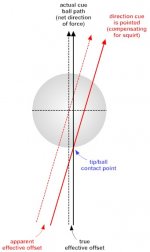It is pointless....
Someone will come on with more undeniable proof and he'll say"they have to be the same weight in the first five inches of the shaft. Which eliminates LD technology.
No matter what anyone shows or says, there are no winners..... As has already been stated, based on the original criteria, he should've paid up about 5 times already.
Jaden
BRKNRUN said:I am agreeing with the masses...This thread is pointless at this point until you give enough details to work from...You leave them out and then cry fould when someone comes up with a viable winner.
You admitted that a heavier cue will produce different results (when each cue is struck at the same speed)...but you say that does not count....
Now you above say that the angle off the rail is "longer" ...(at least you threw in a "undetermined limited range"
That is kind of crucial informaion don't you think?.... Based on your diagram above how can you really prove it is the extended time on the rail and not the "swerve" of the CB before it makes impact with the rail causing a different impact point on the rail and a longer angle?
From low speed to high speed (even with right hand english) I belive a frimly struck ball "shortens" the angle....especially on "grabby" rails that reduce the amount of spin at impact......but again...this is all worthless since we don't have any set speed amounts to determin results.
Someone will come on with more undeniable proof and he'll say"they have to be the same weight in the first five inches of the shaft. Which eliminates LD technology.
No matter what anyone shows or says, there are no winners..... As has already been stated, based on the original criteria, he should've paid up about 5 times already.
Jaden
